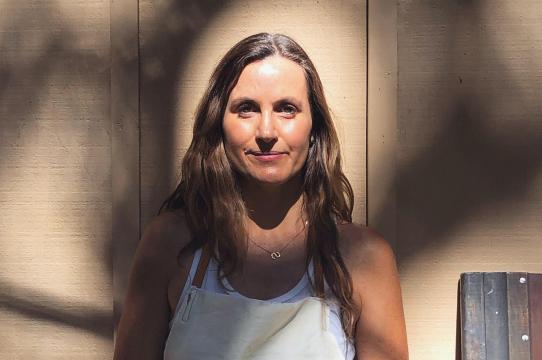“In this time of unprecedented challenges, I find it’s ok to let go of normal expectations,” advises Sarah Sanford, one of the Art Division’s newest faculty members. After having transitioned to teaching online during the last spring quarter when COVID restrictions were being put in place, she tells her students to try their best, be flexible, stay open to possibilities and, perhaps most importantly, maintain a sense of humor.
Sanford knows all too well what it means to switch gears without missing a beat. An artist whose work has been exhibited nationally and internationally, she studied art education at the joint program of Case Western Reserve University and The Cleveland Institute of Art, the Lacoste School of the Arts, France, and then lived in Scotland for several years while earning her MFA in printmaking at the Edinburgh College of Art. Her practice incorporates photography, printmaking, drawing and installation to create hidden worlds of biological landscapes and scientific abstractions.
One of six children who had an idyllic childhood in Kalamazoo, Michigan, Sanford became known in her family as the “artistic one” and convinced her parents to enroll her at the Kalamazoo Art Institute. She also has fond memories of writing plays and creating stage sets and costumes. “We would work on whole productions and then perform them for our parents and the rest of the neighborhood,” she says. “Little kids would play special parts, while us older kids would take the lead roles and direct. In some ways these early acts would reveal my path into becoming a teacher. I have always loved the mixing of creative entities in unstructured play that lead to creating something new and unique. I believe that freedom of creativity heightened my love and early desire to be an artist.”
Ironically, Sanford’s twin sister is a math teacher which might explain why, as an artist, Sanford has also been drawn to science and exploring genomics, cell biology and the ecological impacts of climate change.
“My interest in the crossovers between art and science also came at an early age,” remembers Sanford. “My father is a retired physician, and I recall around the age of 10 or so being drawn to the covers of his JAMA (Journal of the American Medical Association) magazines. I gradually looked deeper inside these journals and fell in love with the images from different research articles, in particular microscopic imagery….I was immediately fascinated with this interior world that lies inside us. I have been intrigued with such complex structures ever since, and my work continues to explore our microcosmic and macrocosmic worlds.”
Another personal link to the sciences includes her husband, Jeremy Sanford, who is a professor of molecular, cell & developmental biology at UC Santa Cruz. They moved to Santa Cruz in 2008 when he took the faculty position and immediately fell in love with the area, settling in Bonny Doon which reminded them of their time in Scotland.
Sarah Sanford actually started teaching part-time at UCSC ten years ago when she proposed a new course called Introduction to Silkscreen. “Over the years, with the continued help of print faculty and staff, I have had the wonderful opportunity to design and help build this area within the department and watch it grow,” she says.
Inspired by nature, Sanford is attracted to the ethereal characteristics of light and it changes everyday scenes. “Photography offers a view through the lens that allows me to crop and contain the visual areas I want to focus on. Printmaking in general provides certain boundaries, yet opportunity is always there throughout the process to reconfigure through the manipulation of matrices and such,” she says.
She appreciates teaching at UC Santa Cruz due to its mix of tradition and innovation, and how her individual voice and expertise are valued. “Looking ahead, this makes it an exciting place to be and a place I want to grow in my career as an artist and art educator.”
As a mother of two, she’s discovering the challenges that working parents are facing with work/life/career balancing, especially during the restrictions of a living in a pandemic. But Sanford remains optimistic and sees it as a growth opportunity, allowing for gaining new perspectives that can stretch one’s abilities.
“Any challenging situation brings growth. Limitations teach you to re-think and gain new perspective and this ultimately expands your abilities and mindset,” she observes.
As she continues with her art practice that interfaces art and science, Sanford’s insight into such seemingly different disciplines further informs her work. “Although our practices and instrumentation may be different, there is an appreciation that happens when we understand underlying mechanisms,” Sanford explains. “Artists bring appreciation to those mechanisms by offering new and different perspectives through works of art. Not merely here to re-represent them, but to reveal new and deeper connections to how we understand our world.”


